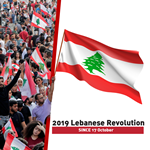Lebanon and the 17 October Revolution: Are we back to the bottom?
Published on Fri, 2020-02-07 08:56
The formation of the new Lebanese government on 21 January 2020, nearly one hundred days after the eruption of the popular protests, is an important milestone in the first stage of the confrontation between the “revolution” and the authorities. This has raised questions and discussions among activists and groups whether the revolution has made progress, or the formation of the government constitutes a return to the bottom, to pre 17 October period. So what has the revolution achieved against the regime? Indeed, the revolution has had accomplishments on two levels, the authorities’ and popular levels. Within 100 days, the revolution has achieved the following: 1. The overthrow of the so-called presidential settlement that led Michel Aoun to become president and to produce a parliament based on an unconstitutional electoral law, and thus the rise of a new political majority, and the formation of a coalition government constituting seven major political parties. Achieving this presidential settlement and government came with a high price, including the conciliation of regional and local powers, frequent disruption of the work of the parliament and government, and very intense popular, security and political pressure. And therefore, the overthrow of this settlement is one of the key highlights of the revolution. 2. The overthrow of government, which is the executive power within the settlement and the weakest component, given that the PM was the weakest among power holders (Hezbollah, Amal movement and the Free Patriotic Movement). 3. The interruption of two parliamentary sessions and the adoption of equivocal draft laws listed on the agendas constitutes a major highlight, given that the power of the people and protests has been never able to cancel a parliamentary session. 4. Causing disruption within the ruling coalition and between the components of the authorities, which was expressed by the resignation of the government and the confusion that prevailed in the process of forming the new government, especially when two PM candidates were let go for failing to meet the minimum profile accepted by the revolution (and due to other auxiliary factors as well). During this lengthy process, acute differences and contradictions were revealed between the allied parties despite belonging to the same block. The formation of such a government is a sign of weakness rather than a sign of strength. The authorities have not made explicitly or publicly any concession to the revolution’s demands, and this could be interpreted as a sign of strength whereby the authorities are operating independently and in spite of the ongoing protests. Yet, other interpretations believe that not making any concessions to the protestors is a sign of weakness, because only the strong, coherent and self-confident party will be able to make concessions and reach compromises. And because the weak party stiffens and clings to its positions because any concession, no matter how small and limited, may open the door to other concessions that cannot be controlled, and may lead to undermining its authority. Transitions at the popular level It is uncontested that the revolution has increased popular awareness through thousands of initiatives and discussions, and the decentralized nature of the protests across all cities and villages from the far south to the far north and east, that have included all social and age groups. This diverse and inclusive revolution has contributed to first, break the rigid sectarian and regional political discourse, second, disrupt traditional loyalties, and finally break down the barriers between social groups and regions. Perhaps in the opinion of some, this positive shift cannot be considered complete, but there is indeed a consensus that it is a very important and irreversible shift, which will remain despite any setbacks. We must hence be confident that a significant progress has been made in regards to popular awareness and the social groups’ movements have advanced to direct political action in the streets. Before 17 October, we were faced on one hand with plenty of political alliances, which despite their differences, proceeded in these alliances that equally served their interests, and on the other, with citizens who were thought to be radically loyal to the traditional political leaders. Yet today, after one hundred days of revolution, we have become in front of a government which its quorum is made up of only a few parties, and an alliance accused of corruption and failure; and in parallel, people and citizens struggling in the streets to defend their rights, and stand against the traditional leaders and the corrupt system. The revolution did not fail, but has achieved certain gains during the first round, and is preparing for the next rounds. We, the people and the revolution, are much stronger than some think. And the authorities are much weaker than they pretend. By Adib Nehmeh. |
SUSCRIBE TO OUR NEWSLETTER



